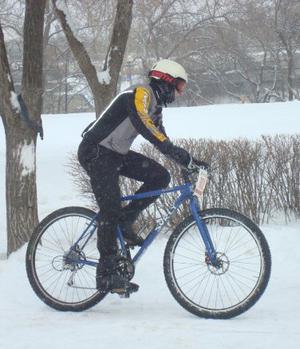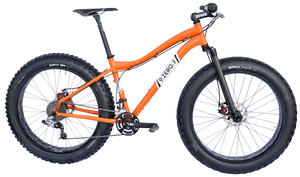Winter Cycling
Intro to Winter Cycling
|
Over the past handful of years the staff at the store have noticed an increase in the popularity of winter cycling. We frequently get folks coming into the store for information on commuting and riding in winter and many of them have the same questions. Most of our staff commute in winter and have encountered just about every condition and problem imaginable. The following is a list of tips and advice for cycling in winter in Winnipeg. Firstly and most importantly every single person is different and what works for us might not work for you. |
 |
General Tips
The first tip I can give about cycling in winter is that the first six feet is the hardest. If you get out the door without the car keys in your hand, congratulations the hardest part is done!
The second tip is to keep a bus ticket tucked away or have an alternative way home planned. The weather in winter can be unpredictable and a heavy snowfall during the day can make a typical ride home into a two hour walk/bike push. Also there are days where conditions make being on the roads with drivers frightening. When you start riding in winter you will start checking the weather forecasts regularly. Pay particular attention to temperature, wind speed and direction.
Route planning is important to make commuting enjoyable and safe. Realize that your route may change between summer and winter. In winter certain roads may become difficult or dangerous to ride on. I am going to stop short of advocating riding on the sidewalks but a ticket may be better than being hit by a car. In Winnipeg we have a wonderful resource in the river trail system. Cycling along the river walk and cleared skating paths on the Assiniboine and Red Rivers are very pleasant and car free.
Keep the furnace fueled. ALWAYS have a large snack to small meal's worth of food with you. You have no hope of staying warm if your blood sugar is low. Staying hydrated is as important to warmth as food. It can be difficult to drink on the bike in the cold. Water bottles freeze as do the hoses and valves of water packs. An insulated water bottle or thermos in a back pack is a good option though less likely to be used. I simply drink a lot of water at work during the day. Remember that you can eat your water in the form of soups, stews and moisture laden fruits and vegetables.
Energy expenditure goes up in the cold as some of your energy goes to keeping you warm. Speeds get slower and the same commute as summer may take 15-20% more time. In poor conditions it can double or more. This all leads to working harder for longer. Don't be surprised If you are hungry more often. Make sure to adjust meal portions. If you are trying to loose weight this works in your favour but make sure to remember food equals warmth.
Clothing
Clothing in winter is more important than the bike. The right clothing keeps you warm and dry and makes the difference between having a fun ride and suffering threw your ride. Try to dress so that you are cold for the first 10 minutes of your ride. This will help you to not be over dressed once your heat rate comes up. The usual information about dressing in layers with wool or synthetic fabrics to wick perspiration away from the skin applies to winter cycling and is very important. You want a baselayer that is form fitting to help with moisture transfer but not too tight as to be restrictive. Follow with a midlayer (or two based on the temperature) and a jacket to block the elements.
The trickiest body parts to dress for winter are the head, hands and feet. Again the right fabrics are important as head, hands and feet tend to be high moisture areas. In winter I always have a clean dry pair of gloves (mitts) socks and extra balaclava in my bag along with a long underwear top and bottom.
When you arrive at you destination make sure to change out of your sweaty cycling clothes as soon as possible and set your clothing out to dry. Remember to set out your gloves and socks also. If it looks like a laundry bag exploded you're doing it about right. I usually put my gloves on the end of my bike handlebar to hold them open. I have also seen people use the cardboard toilet paper tube to hold gloves open to help them dry.
Cycling shoes or not? Tough choice. It seems to depend on how easy it is for you to keep your feet warm. Cycling shoes and clipless pedals help keep your feet on the pedals and give you more control over the bike. They are not typically designed to be warm (there are a few winter shoes available) and the stiffness means that your feet don't flex as much so blood dosen't circulate as well. Also some people really notice the metal cleat as a cold spot under the ball of the foot.
| Winter cycling shoes tyically have little or no ventilation. Many are insulated to varying degrees and have softer rubber and more flexible soles for better walking. The Shimano MW81 is a staff favorite, your feet will thank you for the investment! A casual commuter shoe that has a hiking type sole sized with room for extra socks and a neoprene over bootie is also a popular setup. Some people have too difficult a time keeping their feet warm and choose to use flat pedal and a winter hiking type boot. |
Shimano MW81 Winter Shoe |
Headwear like hats, balaclavas and face masks are essential. Make sure to try them on with your helmet as they can get tight or restrictive. Windstopper fleece is an excellent fabric and really shines in head and hand wear. While not certified for cycling many people use a snowsport helmet in winter for the added warmth.
Your Winter Bike
| Cycling in winter is hard on your bike. Salt, sand and moisture cause corrosion issues and accelerate wear on components. There are too schools of thought on bikes for winter, either a disposable inexpensive bike (garage sale special) or purpose built to handle corrosion and low temperatures. | |
|
9:ZERO:7 Fat Bike |
Traction is a major concern in winter. Studded tires are available for icy conditions but can be slippery on bare pavement. Knobby tires work pretty well in snow. Narrow versions cut through loose snow to find traction on pavement below. Speciality bikes that use ultra wide 4"-5" tires work well providing floation and bump absorption as well as large contact area. They're also a lot of fun to ride! |
| A worth while modification to any bike is changing to low temperature grease. At temperatures below -10C standard grease starts to thicken. This thickening results in significant resistance that has to be overcome by the rider and is more apparent the colder it gets. | |


